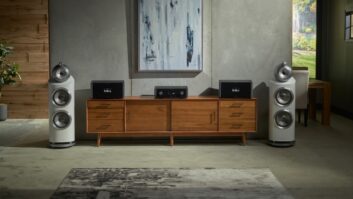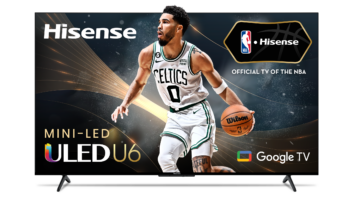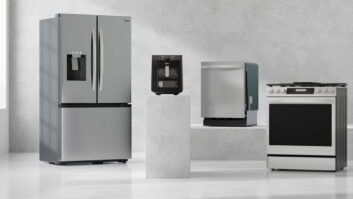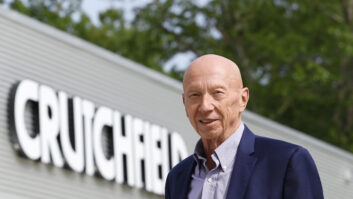TWICE:What does the future hold for CE retailing?
Steve Caldero, Ken Crane’s: Dealers have to decide who they are and what they want to be. Best Buy knows exactly who they are. They know they’re supply chain-centric, as is Wal-Mart. They’re a football team. They have a quarterback that runs the show — everything works.
You’ve got some custom houses like Starpower in Dallas and Definitive Audio in Seattle that are probably more like a baseball team. They have specialists that know how to do control, wiring and so forth. Like Microsoft, they are focused on having experts in every part of their business just like a baseball team has a pitcher, a shortstop and an outfielder.
Other retailers like Nordstrom’s are more like a soccer team because people are empowered to make decisions there, and they have a collective view of where the goal is and where everybody’s going.
In the past, we’ve had this open business because of the HD transition, where people didn’t have to define themselves. They’ve been able to pull along with the rising tide, but the tide’s going down. We’ll see a falling out of those who can’t define who they are and where they belong in the mix.
You’ll have to have a real purpose in life, or the consumer will go somewhere else. We have a short attention span for retailers. The consumer has an even shorter one; they’ll go wherever they can find what meets their needs. If no one’s there to explain that there’s an experience that they’re missing, then it’s all about price and convenience.
What Amazon does online is phenomenal in treating customers and being able to research product, and more people are looking at that. But you can’t show 240Hz versus 120Hz on Amazon. That’s where the retail experience still exists, where it’s a visual, experiential thing.
Tom Galanis, Sixth Avenue Electronics: But what value do you add? That’s the point.
Caldero: Exactly. We have to stop selling products and start selling experiences, which is the hardest thing to get across to salespeople. Best Buy has proven they can out-supply chain anybody, although Wal-Mart can out-supply chain Best Buy when it comes to taking out costs. We’ll never win that battle, so we have to find another purpose in life, or we won’t be here.
TWICE:All while controlling your costs.
Caldero: Yes. We’ve looked at everything from the courier service to the light bulbs to how many times they clean the office. We’ve gone through every line item in our budget to see where we can we take costs out of the business.
TWICE:Where else can you wring out costs?
Galanis: As far as the installation side of it, you need people that can do more than one function. In the appliance/TV store, the traditional salesman may or may not know what 240Hz is. He doesn’t know how to put together a system or wire it up himself, or program a remote, or manage an installation. That’s one form of efficiency.
Another is how you buy, how you distribute goods, how you can take costs out of the business. As a retailer you have to become more efficient, and your people have to become more efficient. You have to see the average of what you sell and not look at categories in terms of “I’m making 8 percent on this, 12 percent on that.” Some things you’re not going to make money on. Some things are just a service that you have to provide.
TWICE:What about expansion? Do you take advantage of the real estate opportunities?
Galanis: Absolutely. We’re going to take advantage and expand in 2009. There are a lot of good opportunities out there, and a lot of nice spots that will come up. A lot of people will go away, and we’ll take advantage of that.
Caldero: But it’s got to be intelligent expansion. You have to look at all the factors. It’s not just a matter of what’s available, but how does that piece accentuate what you’re already doing? A lot of people thought, “The space is available, let’s go for it.” That has pulled back a little bit in the sense that it has to be a much more planned-out process.
Richard Glikes, HTSA: There’s been a lot of rent abatement gong on lately too, which is a good thing.
Dave Workman, PRO Group: Retailers that have all the things Steve’s talking about will probably expand through this. If you have your niche and you can communicate that to the consumer, this is an opportunity-rich environment because of space availability, rents, and so forth.
Again, I think the larger issue is defining yourself. But even more challenging is how you communicate that. If your differentiation is built around experience, that’s probably the hardest thing to communicate to a customer, so we back up on product and price a lot of times. Experience, by definition, is something you have to actually experience.
Ross Rubin, The NPD Group: If the focus is on experience — demonstrating potential in these connected products — does there have to be somewhat of a culture shift from the focus on quality and 240Hz refresh rates when you’re talking about putting a YouTube video up on that screen, or distributing an MP3 music file throughout the house?
Workman: It’s the application. The differentiation is being able to show and communicate the application. In every case, if all you’re doing is talking about an individual product — an Apple TV or an iPhone or what have you — at some point the product is the commodity. The solution is the value-add, and solutions are very difficult to communicate to the consumer.
Glikes: We have another problem. The young people don’t like to shop. Kids are used to buying things online.
Galanis: But that will change with age.
Glikes: I’m not sure about that. They can get, with a touch of their finger, virtually anything they want these days, and they don’t like to go to stores. We’re bringing up a generation of people who are used to having it brought to them.
That’s a big change that many retailers haven’t properly addressed. There will always be a market for craftsmen. You want a piece of marble for your kitchen? That’s where some people will survive. But the young people are doing their shopping on Web sites.
Galanis: How do you sell an Apple TV online? There’s no way. It’s a white box — you can’t experience it.
Everything has a place in this industry, and retail is not going to completely go away. It’s an impossibility.
Workman: Another challenge is that we’ve always had mass-marketed products, and prices have always been very competitive. If you look at ads from 20 years ago, there was always something being advertised for $50 below cost, and you would make the choice if you wanted to play the price game and battle over that $199 price point.
What specialty retail was able to do in many cases was rally around brands you could build, that had a mystique associated with them in your showroom. A good sales force would have been able to talk about features and performance. Then that product would go into the marketplace, and there would be word-of-mouth buzz around it. And the consumer had to go to the specialist to get it.
You made the choice, depending on the nature of your business, to slug it out with the mass marketers on a commodity-type product. Your business could be then worked to have a certain amount of havens where you could start building your solution applications.
Today that has been largely removed for the specialty retailer. You don’t have those traditional havens, and you’re battling price up and down the line.
The question is, can you afford to fight that battle and still compensate an educated person on your floor to develop the solution, given the cost structure that it takes? That’s the conundrum we have as an industry. The industry has to support a certain level of margin to support a certain type of person to deliver the end result. That’s where the partnership is not as strong as it should be, and needs to become stronger in these tough times. Manufacturers and retailers have to work together to try to fix this. There are solutions out there.
Caldero: But the world has changed. Brand names used to mean something to the consumer. Now Vizio is a brand name.
Glikes: I don’t think they’re as important as they were in the past. You’re right about that.
Caldero: All the rules have changed. Ten years ago, who would have bought a Samsung TV? Vizio came from nowhere, a company with no infrastructure or investment in overhead, and it delivers a product to Costco that now becomes acceptable for an upscale, $100,000-plus-income consumer to have in his home. When has that happened before?
Rubin: A lot of that is online word-of-mouth and buzz. That’s how the word gets out about a brand like that.
Caldero: The rules have changed. It’s not business as usual. It’s not the way we grew up in this industry.
Galanis: But human nature doesn’t change, and that’s something I have faith in. If you’re doing a little better than your neighbor, you won’t want that Vizio on your wall because your ego won’t let you have it. Even though the technology difference is subtle, you’ll want to buy a better product.
TWICE:How did those restricted brands first gain their mystique way back when?
Workman: Some of it was the fact that it wasn’t available everywhere. Arguably, you were charging a huge premium for a marginal increase in performance. The cost increase vs. the marginal aspect of performance was never a good relationship.
That’s true in just about every category. Think about a watch; you had Patek. Suddenly Patek is selling at Costco. How special is Patek then in five years? You can go through fashion, jewelry, automobiles, any example. Once you’ve diluted the market and spread the product out, then the mystique is gone.
We’ve drifted away from certain disciplines. Some brands have spread themselves out so far, and now have to realize what they have wrought. Suddenly it’s “Why can’t I sell above-$2,000 receivers?” Maybe because everybody in the world is selling your $2,000 receiver and it’s not special anymore.
Other industries have recognized that if you want to maintain mystique, you can’t have it everywhere all the time.
Caldero: Retailers have lost discipline as well. You used to have two receiver lines that you focused on and that your people were trained on. Then the doors opened up and you had to have six receiver lines, so nobody was important to anybody. It’s a two-way street.
Workman: It’s always been.
Caldero: Does Sony really need 13 lines of TVs?
Galanis: Water always finds its level. Human nature is not going to change. Even down to tools — a tool is not very sexy or entertaining, yet you can buy a wrench for $5 or you can buy a DeWalt for $50. It has some qualitative difference.
Workman: And not everybody can sell DeWalt.
Galanis: It’s a correction process. Manufacturers went full-tilt to the downside, and they’re going to have to come back, the same way there are too many retailers out there. It’s going to correct itself.
Workman: There are capabilities that have been lost downstream. This is the big fear for the specialist — at what point does the manufacturer look up and say it’s no longer profitable to manufacture upscale goods?
We all have a vested interest in seeing this thing get course-corrected. If that can happen, hopefully there can be better disciplines in the marketplace down the road. Things have drifted too far in the past and have come back. It’s not like it’s been stagnant.
Galanis: It’s like a pendulum — it just keeps swinging back and forth.













